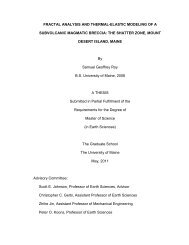Jumars, P.A. - University of Maine
Jumars, P.A. - University of Maine
Jumars, P.A. - University of Maine
You also want an ePaper? Increase the reach of your titles
YUMPU automatically turns print PDFs into web optimized ePapers that Google loves.
NEW SPECIES OF NORTH PACIFIC DORVILLEID POLYCHAETES 125<br />
Remarks. Ophryotrocha includes the following species : O. puerilis Claparede<br />
& Mecznikow, 1869 ; O . geryonicola (Esmark, 1878) ; O . claparedii Studer,<br />
1878 ; O. littoralis (Levinsen, 1879) ; O . hartmanni Huth, 1933 ; O. minuta Levi,<br />
1954 ; O . bacci Parenti, 1961 ; O . labronica La Grecca & Bacci, 1962 ; O. vivipara<br />
Banse, 1963 ; O . notoglandulata Pfannenstiel, 1972 ; and, the new species<br />
described herein .<br />
Ophryotrocha puerilis Claparede & Mecznikow, 1869<br />
Ophryotrocha puerilis Claparede & Mecznikow, 1869 : 184 ; Fauvel, 1923 :<br />
450, fig . 180 a-h ; Hartman, 1944 : 191, pl . 15, figs 325-330 ; Day, 1967 :<br />
452, fig . 17 .20 a-f.<br />
Material examined . Three specimens from Naples (MNHN) and one example<br />
without locality data (MNHN) were dissected for pharyngeal examination .<br />
Description . Fauvel (1923), Hartman (1944), and Parenti (1961) all illustrate<br />
the denticles <strong>of</strong> O . puerilis as being <strong>of</strong> two distinct types . Those denticles with<br />
a distinct main fang are interpreted as the products <strong>of</strong> fusion <strong>of</strong> falcate superior<br />
denticles and plate-like inferior denticles ; those without a main fang are<br />
thought to belong to the inferior row . In the following, newly described<br />
species, two free, falcate denticles remain in each albeit short superior row<br />
(Fig . 12F) . The ice-tong-shaped forceps in O. puerilis is believed to be the<br />
product <strong>of</strong> the fusion <strong>of</strong> carriers and all four basal plates . (For a description <strong>of</strong><br />
a similar process <strong>of</strong> fusion, see Sudzuki & Sekiguchi, 1972, who discuss the<br />
ontogeny <strong>of</strong> the maxillary apparatus in O . notoglandulata .) As Parenti (1961)<br />
illustrates, all that is apparent in the adult maxillae is one forceps continuous<br />
with two rows <strong>of</strong> diversely shaped denticles ; the fusions in O . puerilis are all<br />
inferred .<br />
Remarks . One <strong>of</strong> the specimens from Naples reveals maxillary replacement in<br />
Ophryotrocha to be like that in Dorvillea, Schistomeringos, and Protodorvillea .<br />
The worn parts are underlain by their still forming replacements .<br />
Distribution . The species has been considered cosmopolitan in tropical and<br />
temperate intertidal regimes (Day, 1967) . In light <strong>of</strong> the experimental evidence<br />
by Bacci & La Grecca (1953) demonstrating the lack <strong>of</strong> successful interbreeding<br />
in populations from as close as Naples and Plymouth, it is considered<br />
unlikely that even more distantly separated populations are conspecific .<br />
Furthermore, Banse (1963) has noted radical differences in the mating<br />
behaviours in populations from western North America and Europe .<br />
Ophryotrocha hadalis sp . nov.<br />
(Fig . 12)<br />
Material examined . Four specimens from SIO H39 (AHF Poly . 1079-80) were<br />
externally examined . The holotype remains in alcohol, while the three<br />
paratypes were cleared and mounted whole .<br />
Description . The holotype measures 1 .3 mm long by 0 .14 mm wide and has<br />
22 setigers ; the largest paratype is 3 .7 mm long and 0 33 mm wide but is so<br />
battered that the number <strong>of</strong> setigers is indeterminable . An arcuate ridge is
















